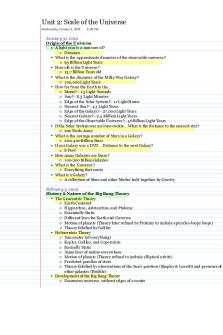Unit 2 Scale of the Universe Notes PDF

| Title | Unit 2 Scale of the Universe Notes |
|---|---|
| Author | Conner Ferney |
| Course | Science Foundations |
| Institution | Brigham Young University-Idaho |
| Pages | 4 |
| File Size | 158.6 KB |
| File Type | |
| Total Downloads | 23 |
| Total Views | 165 |
Summary
Download Unit 2 Scale of the Universe Notes PDF
Description
Unit 2: Scale of the Universe Wednesday, January 9, 2019
8:20 PM
January 31, 2019: Origin of the Universe • A light year is a measure of? ○ Distance What is the approximate diameter of the observable universe? • ○ 93 Billion Light Years • How old is the Universe? ○ 13.7 Billion Years old • What is the diameter of the Milky Way Galaxy? ○ 100,000 Light Years • How far from the Earth to the… ○ Moon? - 1.3 Light Seconds ○ Sun? - 8.3 Light Minutes ○ Edge of the Solar System? - 11 Light Hours ○ Nearest Star? - 4.3 Light Years ○ Edge of the Galaxy? - 27,000 Light Years ○ Nearest Galaxy? - 2.5 Million Light Years ○ Edge of the Observable Universe? - 46 Billion Light Years • If the Solar System was an Oreo cookie… What is the distance to the nearest star? ○ 2oo Yards Away • What is the average number of Stars in a Galaxy? ○ 200-400 Billion Stars • If our Galaxy was a DVD… Distance to the next Galaxy? ○ 8 Feet • How many Galaxies are there? ○ 100-200 Billion Galaxies • What is the Universe? ○ Everything that exists • What is a Galaxy? ○ A collection of Stars and other Matter held together by Gravity February 5, 2019: History & Nature of the Big Bang Theory • The Geocentric Theory ○ Earth Centered ○ Hipparchus, Aristarchus, and Ptolemy ○ Essentially Static ○ Different laws for Earth and Universe ○ Motion of planets (Theory later refined by Ptolemy to include epicycles-loopy loops) ○ Theory falsified by Galileo Heliocentric Theory • ○ Sun center (of everything) ○ Kepler, Galileo, and Copernicus ○ Basically Static ○ Same laws of nature everywhere ○ Motion of planets (Theory refined to include elliptical orbits) ○ Predicted parallax of stars ○ Theory falsified by observations of the Sun's position (Shapley & Leavitt) and presence of other galaxies (Hubble) • Development of the Big Bang Theory ○ Enormous universe, without edges of a center
○ Provided by Einstein, Curtis Shapley, Hubble ○ Constantly expanding, evolving universe Galaxies moving apart ○ Same laws of nature everywhere • Predictions of the Big Bang Theory ○ Expanding universe ○ Universe made mostly of H (Hydrogen) and He (Helium) ○ Residual energy ○ Evolving galaxies & universe February 7, 2019: What is Light? • What is a Wavelength ○ Is the opposite/inverse frequency ○ Blue = Higher energy ○ Red = Lower energy • What can we learn from light? ○ Distance Interpreting Position and Brightness: □ Parallax/Position 1,000 Light years □ Standard Candle/Brightness An object of known brightness Used when greater/farther than 1,000 light years ○ Composition Interpreting Spectrum: □ Spectrum = Fingerprint/Barcode ○ Direction/Velocity
Study CMB
February 12, 2019: Expansion & Residual Energy (CMB) • How Hubble Discovered Galaxies? ○ Measured the distance to distant stars ○ They were ~ 2.5 million Light Years away Too far away to be in our galaxy They were part of the Andromeda Galaxy, our nearest neighbor • Discovering the Residual Energy ○ 1948 - CMB (Cosmic Microwave Background) predicted by Alpher and Herman ○ 1965 - Penzias and Wilson discovered the Cosmic Microwave Background Radiation (b accident) ○ Generated when the infant universe first became transparent to light -when neutral atoms formed for the first time February 14, 2019: Origin of Elements in the Evolving Universe • Universe made mostly of Hydrogen and Helium ○ Small stars -> Carbon (#6) ○ Large stars -> Iron (#26) ○ Supernova -> Everything Else ○ ~ 75 % of a star is made out of Hydrogen ○ ~ 25 % of a star is made out of Helium Evolving Galaxies & Universe • ○ Farther away, they look younger • Big Bang Theory ○ Redshifts of Galaxies (Expansion) ○ Cosmic Microwave Background (CMB)
○ Abundance of Light Elements (H & He) ○ Distribution and Evolution of Galaxies (Farther away look younger)
Study Quizlet...
Similar Free PDFs

A Corner of the Universe
- 73 Pages

Life in the Universe Notes
- 52 Pages

3.3.3 Economies of scale
- 7 Pages

The Elegant Universe - Brian Green
- 190 Pages

Unit 2 - Lecture notes Unit 2
- 30 Pages

Tinbergen Universe
- 2 Pages

Phil unit 2 - Lecture notes Unit 2
- 12 Pages
Popular Institutions
- Tinajero National High School - Annex
- Politeknik Caltex Riau
- Yokohama City University
- SGT University
- University of Al-Qadisiyah
- Divine Word College of Vigan
- Techniek College Rotterdam
- Universidade de Santiago
- Universiti Teknologi MARA Cawangan Johor Kampus Pasir Gudang
- Poltekkes Kemenkes Yogyakarta
- Baguio City National High School
- Colegio san marcos
- preparatoria uno
- Centro de Bachillerato Tecnológico Industrial y de Servicios No. 107
- Dalian Maritime University
- Quang Trung Secondary School
- Colegio Tecnológico en Informática
- Corporación Regional de Educación Superior
- Grupo CEDVA
- Dar Al Uloom University
- Centro de Estudios Preuniversitarios de la Universidad Nacional de Ingeniería
- 上智大学
- Aakash International School, Nuna Majara
- San Felipe Neri Catholic School
- Kang Chiao International School - New Taipei City
- Misamis Occidental National High School
- Institución Educativa Escuela Normal Juan Ladrilleros
- Kolehiyo ng Pantukan
- Batanes State College
- Instituto Continental
- Sekolah Menengah Kejuruan Kesehatan Kaltara (Tarakan)
- Colegio de La Inmaculada Concepcion - Cebu








